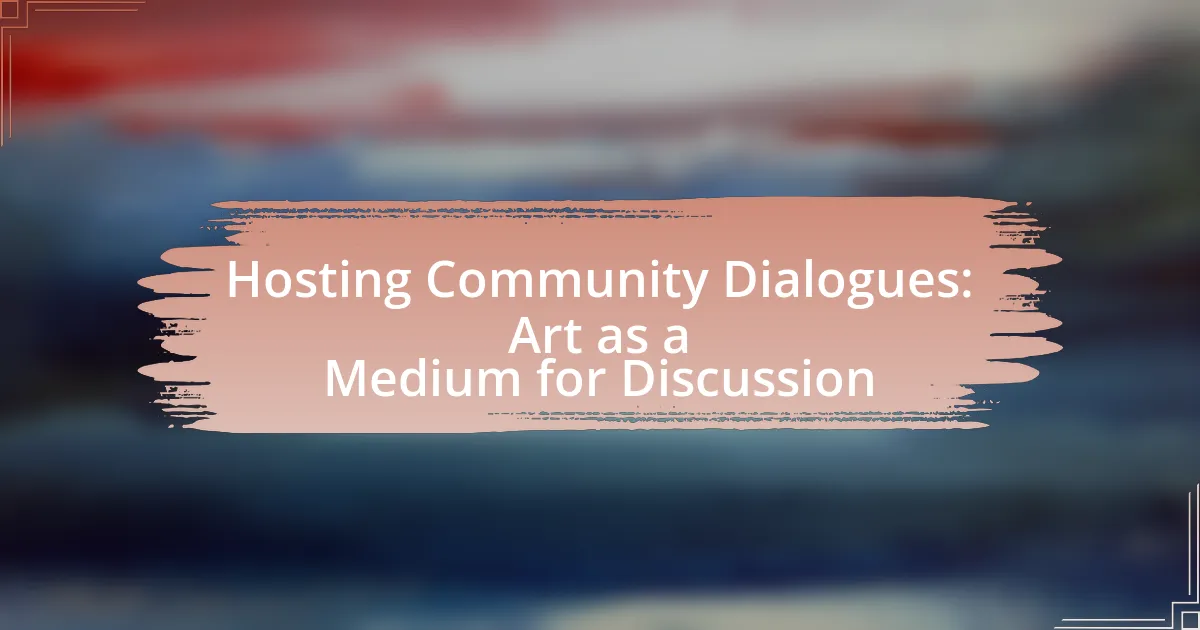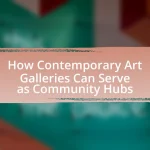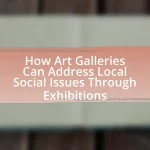The article focuses on hosting community dialogues, emphasizing the role of art as a medium for discussion. It outlines the importance of structured conversations that foster understanding, build relationships, and encourage collaborative problem-solving among diverse community members. Key elements for effective dialogues include creating safe spaces, promoting inclusivity, and utilizing various forms of art to enhance communication and emotional engagement. The article also addresses logistical considerations, strategies for managing differing opinions, and best practices for integrating art into the dialogue process, ultimately highlighting how these dialogues can effectively address social issues and enhance community cohesion.
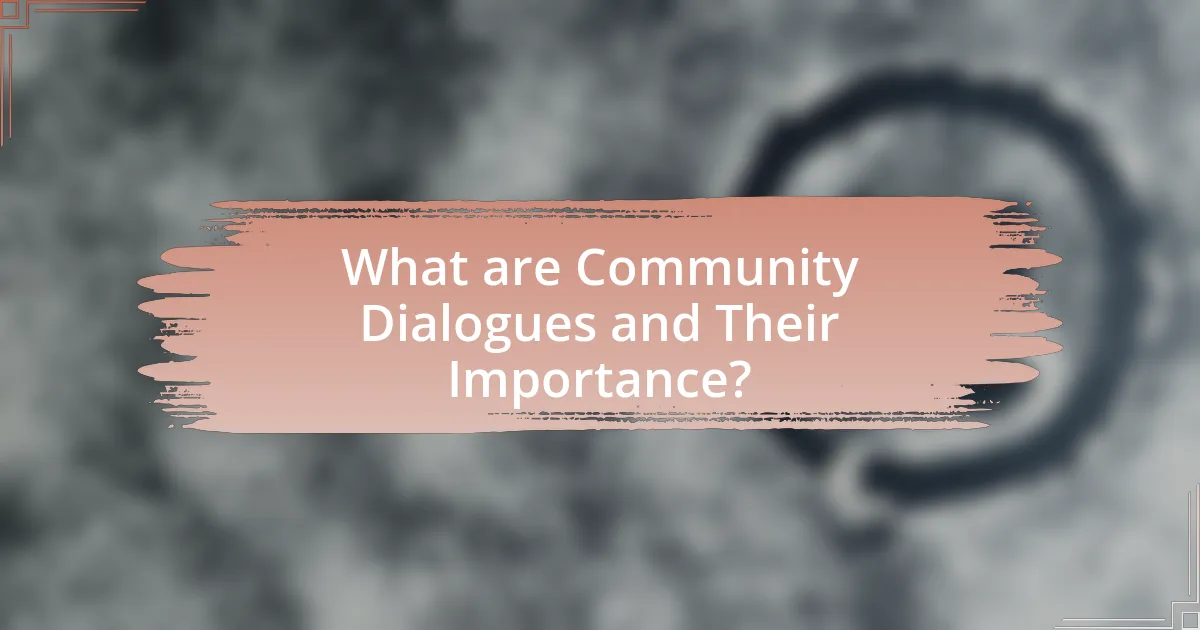
What are Community Dialogues and Their Importance?
Community dialogues are structured conversations that bring together diverse groups of people to discuss issues affecting their community. These dialogues are important because they foster understanding, build relationships, and encourage collaborative problem-solving among participants. Research indicates that community dialogues can enhance social cohesion and empower individuals by giving them a platform to voice their concerns and ideas, ultimately leading to more effective community engagement and decision-making.
How do community dialogues facilitate communication?
Community dialogues facilitate communication by creating structured spaces for individuals to share perspectives and engage in meaningful conversations. These dialogues encourage active listening and foster mutual understanding among participants, which enhances community cohesion. Research indicates that when community members engage in dialogues, they are more likely to express their thoughts and feelings openly, leading to improved relationships and collaboration. For instance, a study by the National Coalition for Dialogue & Deliberation found that structured dialogues can significantly increase participants’ willingness to engage with differing viewpoints, thereby promoting a more inclusive community discourse.
What role does art play in enhancing dialogue?
Art plays a crucial role in enhancing dialogue by serving as a medium that fosters communication and understanding among individuals. Through visual, auditory, and performative expressions, art can convey complex emotions and ideas that might be difficult to articulate verbally. For instance, community art projects have been shown to facilitate discussions on social issues, as evidenced by the “Art for Social Change” initiative, which demonstrated that collaborative art-making led to increased engagement and dialogue among participants from diverse backgrounds. This ability of art to bridge gaps in communication makes it an effective tool for promoting dialogue in community settings.
How can community dialogues address social issues?
Community dialogues can address social issues by fostering open communication and collaboration among diverse groups. These dialogues create a platform for individuals to share their experiences and perspectives, which can lead to a deeper understanding of the issues at hand. For instance, research from the National Civic League indicates that community dialogues can enhance civic engagement and promote social cohesion, ultimately resulting in more effective problem-solving. By involving various stakeholders, including marginalized voices, community dialogues can identify root causes of social issues and develop collective strategies for change.
Why is art considered a powerful medium for discussion?
Art is considered a powerful medium for discussion because it transcends language barriers and evokes emotional responses, facilitating dialogue on complex social issues. This ability to communicate ideas and feelings visually allows diverse audiences to engage with topics such as identity, politics, and culture in a relatable manner. For instance, public art installations often spark conversations about community values and social justice, as seen in the works of artists like Banksy, whose pieces challenge societal norms and provoke thought. Additionally, studies have shown that art can enhance empathy and understanding, making it an effective tool for fostering community dialogue and addressing contentious subjects.
What types of art are most effective in community dialogues?
Visual art, performance art, and participatory art are the most effective types of art in community dialogues. Visual art, such as murals and installations, can provoke thought and discussion by reflecting community issues and identities. Performance art, including theater and dance, engages audiences emotionally and encourages them to explore diverse perspectives. Participatory art invites community members to contribute, fostering collaboration and shared ownership of the dialogue process. Research by the National Endowment for the Arts indicates that these art forms enhance community engagement and promote social cohesion, making them powerful tools for facilitating meaningful conversations.
How does art evoke emotional responses in discussions?
Art evokes emotional responses in discussions by engaging viewers through visual, auditory, or tactile stimuli that resonate with personal experiences. This engagement occurs because art often reflects societal issues, personal narratives, or universal themes, prompting individuals to connect emotionally. For instance, studies have shown that artworks addressing themes like grief or joy can elicit strong emotional reactions, as they mirror the viewers’ own feelings and experiences. Research by the University of California, Berkeley, indicates that art can activate brain regions associated with emotion, enhancing empathy and understanding during discussions. This emotional engagement fosters deeper dialogues, allowing participants to explore complex feelings and perspectives related to the artwork.
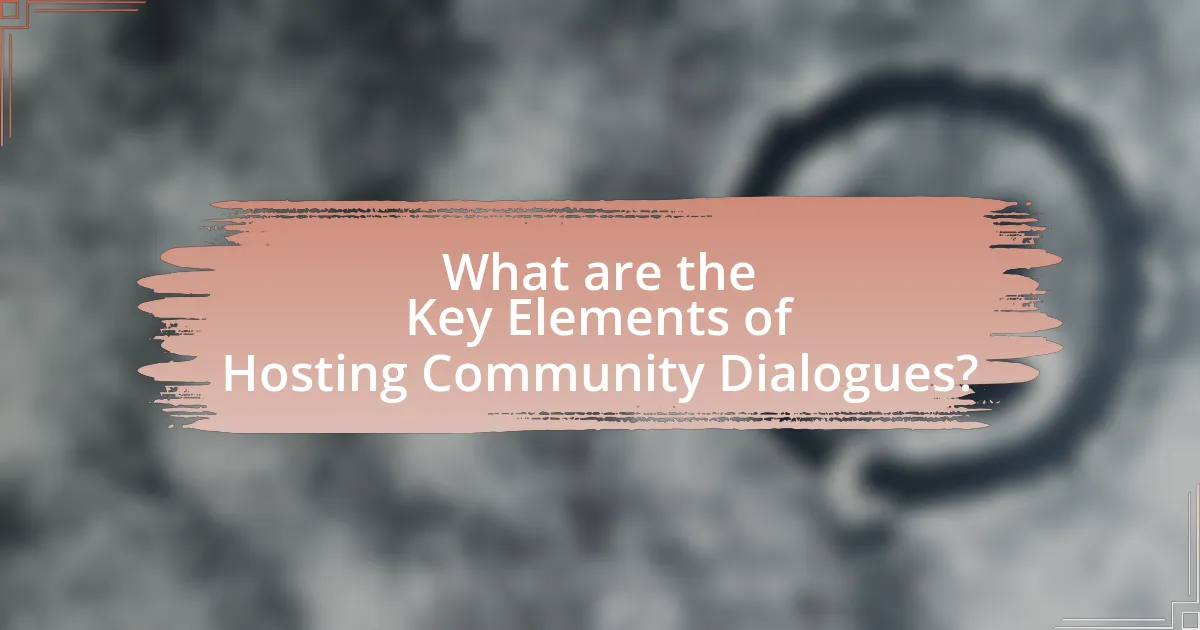
What are the Key Elements of Hosting Community Dialogues?
The key elements of hosting community dialogues include creating a safe space, fostering open communication, ensuring diverse representation, and facilitating active listening. A safe space allows participants to express their thoughts without fear of judgment, which is essential for honest dialogue. Open communication encourages participants to share their perspectives freely, while diverse representation ensures that various viewpoints are included, enriching the discussion. Active listening is crucial as it demonstrates respect for others’ opinions and promotes understanding among participants. These elements collectively enhance the effectiveness of community dialogues, leading to more meaningful and productive conversations.
How can facilitators create an inclusive environment?
Facilitators can create an inclusive environment by actively promoting diverse participation and ensuring that all voices are heard. This can be achieved through strategies such as establishing ground rules that encourage respect and openness, using varied communication methods to accommodate different preferences, and providing resources that reflect the diversity of the community. Research indicates that inclusive practices lead to more effective dialogue and collaboration, as evidenced by a study published in the Journal of Community Engagement and Scholarship, which found that inclusive environments enhance participant satisfaction and engagement.
What strategies promote participation from diverse groups?
Strategies that promote participation from diverse groups include creating inclusive environments, utilizing culturally relevant communication, and providing accessible resources. Inclusive environments foster a sense of belonging, encouraging individuals from various backgrounds to engage. Culturally relevant communication ensures that messages resonate with different communities, enhancing understanding and interest. Accessible resources, such as translation services and varied formats, remove barriers to participation, allowing broader engagement. Research indicates that initiatives incorporating these strategies lead to increased involvement from underrepresented populations, as evidenced by community programs that successfully attract diverse participants through tailored outreach efforts.
How can facilitators manage differing opinions effectively?
Facilitators can manage differing opinions effectively by employing active listening techniques and creating a safe environment for dialogue. Active listening involves acknowledging each participant’s viewpoint without judgment, which fosters respect and encourages open communication. Research indicates that when facilitators paraphrase and validate participants’ feelings, it enhances understanding and reduces tension, leading to more productive discussions. Additionally, establishing ground rules for respectful discourse can help maintain focus and ensure that all voices are heard, ultimately promoting a collaborative atmosphere where differing opinions can be explored constructively.
What logistical considerations are essential for hosting dialogues?
Essential logistical considerations for hosting dialogues include venue selection, participant accessibility, and resource allocation. The venue must accommodate the expected number of participants and provide a conducive environment for discussion, such as adequate seating and sound systems. Accessibility ensures that all participants can attend, which may involve considering transportation options and physical access for individuals with disabilities. Resource allocation involves budgeting for materials, refreshments, and any necessary technology to facilitate the dialogue. These factors are critical for ensuring a successful and inclusive dialogue experience.
How do location and setting impact the dialogue experience?
Location and setting significantly impact the dialogue experience by influencing participants’ comfort, engagement, and openness. A well-chosen location can foster a sense of safety and community, encouraging more honest and meaningful exchanges. For instance, research shows that dialogues held in familiar, accessible spaces tend to yield higher participation rates and more dynamic interactions, as participants feel more at ease in their environment. Additionally, the physical arrangement of the setting, such as seating arrangements and accessibility, can facilitate or hinder communication flow, affecting how ideas are shared and discussed.
What resources are needed to support artistic expression?
To support artistic expression, essential resources include funding, access to materials, and spaces for creation and collaboration. Funding is critical as it enables artists to purchase supplies, pay for studio space, and cover living expenses while they create. Access to diverse materials, such as paints, canvases, and digital tools, allows artists to explore various mediums and techniques. Additionally, dedicated spaces, such as community centers or galleries, provide environments where artists can collaborate, showcase their work, and engage with the public. These resources collectively foster an ecosystem that nurtures creativity and facilitates dialogue through art.
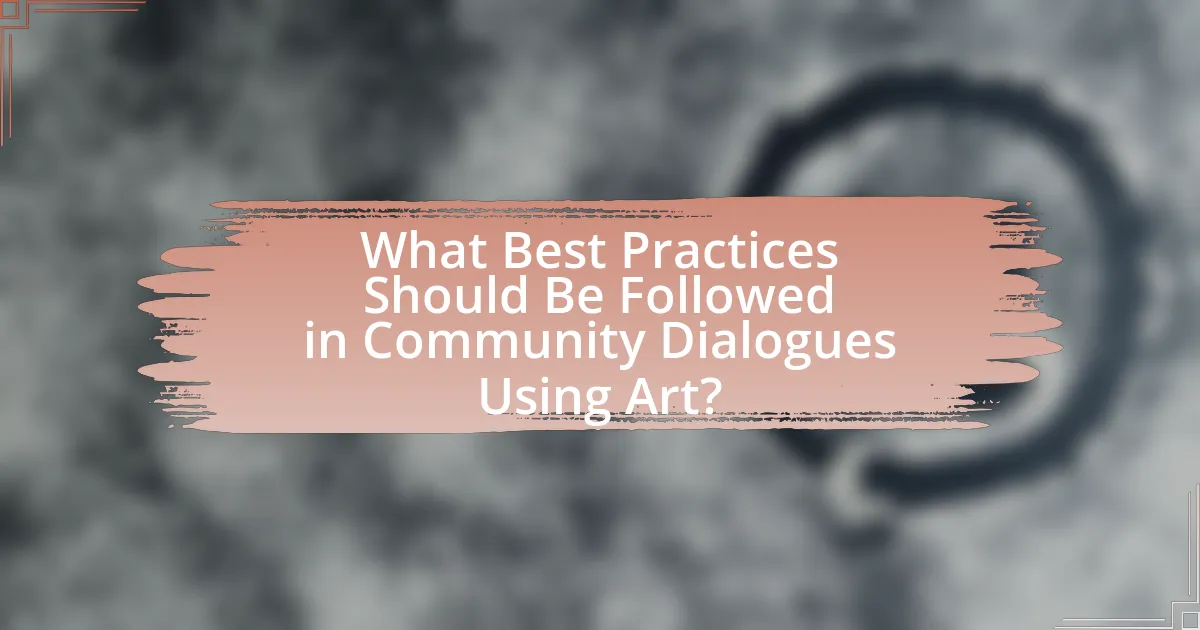
What Best Practices Should Be Followed in Community Dialogues Using Art?
Best practices in community dialogues using art include fostering inclusivity, encouraging open expression, and ensuring cultural sensitivity. Inclusivity can be achieved by inviting diverse community members to participate, which enhances representation and engagement. Open expression is vital; participants should feel safe to share their thoughts and feelings without judgment, promoting a richer dialogue. Cultural sensitivity is crucial, as art often reflects cultural identities; facilitators should respect and acknowledge these backgrounds to avoid misunderstandings and foster trust. These practices are supported by research indicating that inclusive and respectful environments lead to more meaningful community engagement and dialogue outcomes.
How can art be integrated into the dialogue process?
Art can be integrated into the dialogue process by using it as a tool for expression and communication among participants. This integration allows individuals to convey complex emotions and ideas that may be difficult to articulate verbally. For instance, community murals or collaborative art projects can serve as focal points for discussion, enabling participants to share their perspectives and experiences related to the themes represented in the artwork. Research by the National Endowment for the Arts indicates that art can foster social cohesion and enhance community engagement, demonstrating its effectiveness in facilitating meaningful dialogue.
What activities can effectively incorporate art into discussions?
Activities that effectively incorporate art into discussions include art exhibitions, community mural projects, and interactive workshops. Art exhibitions provide a visual context that stimulates dialogue among participants, allowing them to interpret and discuss the themes presented. Community mural projects engage local artists and residents, fostering collaboration and conversation about shared values and community identity. Interactive workshops, such as art-making sessions, encourage participants to express their thoughts and feelings through creative processes, facilitating deeper discussions on relevant topics. These activities leverage the emotional and cognitive engagement that art elicits, making discussions more impactful and meaningful.
How can feedback be gathered to improve future dialogues?
Feedback can be gathered to improve future dialogues by utilizing surveys, interviews, and focus groups. Surveys can be distributed immediately after dialogues to capture participants’ thoughts and feelings, while interviews allow for deeper insights into individual experiences. Focus groups can facilitate discussions among participants about their perceptions and suggestions for improvement. Research indicates that collecting feedback through these methods can lead to actionable insights, as evidenced by a study published in the Journal of Community Engagement and Scholarship, which found that structured feedback mechanisms significantly enhanced the quality of community dialogues.
What common challenges arise in hosting community dialogues with art?
Common challenges in hosting community dialogues with art include ensuring diverse participation, managing differing perspectives, and addressing logistical issues. Diverse participation is crucial as it enriches the dialogue; however, barriers such as socioeconomic status, accessibility, and cultural differences can hinder involvement. Managing differing perspectives is essential, as art can evoke strong emotions and opinions, leading to potential conflicts among participants. Logistical issues, such as securing appropriate venues, funding, and materials, can also pose significant challenges, impacting the overall effectiveness of the dialogue. These challenges are documented in various studies, highlighting the need for careful planning and facilitation to create an inclusive and productive environment for community engagement through art.
How can facilitators overcome resistance to artistic expression?
Facilitators can overcome resistance to artistic expression by creating a safe and supportive environment that encourages participation. This involves establishing trust among participants, which can be achieved through ice-breaking activities and open discussions that validate individual experiences. Research indicates that when individuals feel secure, they are more likely to engage in creative activities (Kester, 2004, “Conversation Pieces: Community and Communication in Modern Art”). Additionally, facilitators can provide clear guidance and structure to the artistic process, helping participants understand the purpose and value of their contributions. By addressing fears of judgment and emphasizing the importance of personal expression, facilitators can effectively reduce resistance and foster a more inclusive atmosphere for artistic exploration.
What solutions exist for managing time constraints during dialogues?
Solutions for managing time constraints during dialogues include setting clear agendas, utilizing timekeepers, and implementing structured formats such as round-robin discussions. Clear agendas help participants understand the topics to be covered and allocate time accordingly. Timekeepers ensure that each segment of the dialogue adheres to the designated time limits, promoting efficiency. Structured formats, like round-robin, allow each participant to contribute within a set timeframe, ensuring that all voices are heard while maintaining the dialogue’s pace. These methods have been shown to enhance engagement and productivity in community dialogues, as evidenced by successful implementations in various community forums.
What are some practical tips for successful community dialogues using art?
Successful community dialogues using art can be achieved by fostering an inclusive environment, encouraging active participation, and utilizing diverse artistic mediums. Creating a welcoming space allows participants to feel comfortable expressing their thoughts and emotions. Active participation can be promoted through interactive art activities, such as collaborative murals or workshops, which engage community members and stimulate dialogue. Additionally, incorporating various artistic forms—like visual arts, theater, and music—can cater to different preferences and enhance engagement. Research shows that art-based community engagement can lead to improved social cohesion and understanding among diverse groups, as evidenced by studies conducted by the National Endowment for the Arts.
